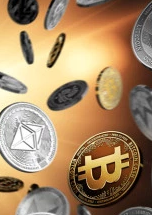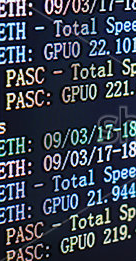How Does Cryptocurrency Work?
What is Cryptocurrency?
Cryptocurrency is a digital or virtual currency that uses cryptography for secure transactions and operates on decentralized blockchain networks. It offers features like decentralization, limited supply, anonymity, and global accessibility. The first and most renowned cryptocurrency is Bitcoin, and thousands of others, known as altcoins, have been created. While cryptocurrencies present opportunities for digital transactions and investment, they also face challenges and regulatory concerns, making them a subject of ongoing interest and debate.
What is Cryptocurrency Mining?

Cryptocurrency mining is the process of creating new digital coins and verifying transactions on a blockchain network. Miners use computational power to solve complex puzzles, adding new blocks to the blockchain and earning rewards in the form of newly minted coins. The mining process involves transaction verification, competitive solving of cryptographic puzzles using the Proof of Work mechanism, and receiving block rewards and transaction fees. Mining is crucial for blockchain security and consensus, and miners often join pools to share computational resources and rewards. However, mining requires substantial resources, leading to increasing competition and energy consumption in the cryptocurrency space.
Cryptocurrency and Blockchain

Cryptocurrency is a digital currency that employs cryptography for secure transactions and operates on decentralized blockchain networks. Blockchain, on the other hand, is a distributed and immutable ledger system that forms the foundation for cryptocurrencies, recording verified and timestamped transactions in a secure and transparent manner. Both cryptocurrency and blockchain operate in a decentralized fashion, eliminating the need for intermediaries and ensuring security through cryptographic encryption and consensus mechanisms. While cryptocurrencies were the initial application of blockchain technology, its potential impact has extended to various industries, exploring uses beyond digital currencies, such as supply chain management, voting systems, and digital identity solutions.
How Does Cryptocurrency Mining Work?
Cryptocurrency mining is the process by which new digital coins are created and transactions on a blockchain network are verified and added to the public ledger (blockchain). Here's a detailed explanation of how cryptocurrency mining works:
- Transaction Verification: When users initiate transactions on a cryptocurrency network, these transactions are broadcasted to the network and added to a pool of unconfirmed transactions.
- Mining Nodes: Miners are individuals or entities with specialized hardware and software known as mining nodes. They participate in the mining process and aim to verify and validate the pending transactions.
- Proof of Work (PoW): Most cryptocurrencies, including Bitcoin, use the Proof of Work consensus mechanism for mining. Miners compete to solve a complex cryptographic puzzle associated with a block of pending transactions. The puzzle requires finding a specific value, called a "nonce," that, when hashed with the data from the pending block and the previous block's hash, produces a hash that meets certain criteria, usually having a certain number of leading zeros. The nonce is continuously adjusted until a valid hash is found.
- Competition: Mining is a highly competitive process, as multiple miners across the network attempt to solve the cryptographic puzzle simultaneously. The first miner to find the correct nonce and solve the puzzle gets to create the next block of transactions.
- Block Creation and Reward: Once a miner successfully mines a block, they broadcast the new block with the verified transactions to the network. The block is added to the blockchain, and the transactions within it become confirmed. As a reward for their efforts, the miner receives a predetermined number of newly minted cryptocurrency coins, known as the block reward. For example, in the case of Bitcoin, the block reward is halved periodically through a process called "halving" to control the total supply of Bitcoin over time.
- Transaction Fees: In addition to the block reward, miners also collect transaction fees paid by users for including their transactions in the block. As the block size is limited, users can choose to include a higher fee to prioritize their transactions for faster verification and inclusion in the blockchain.
- Consensus and Security: Cryptocurrency mining plays a crucial role in achieving consensus across the decentralized network. The competitive nature of mining ensures that malicious actors cannot easily alter past transactions or add fraudulent blocks to the blockchain, making the network more secure.
- Mining Pools: Mining has become increasingly resource-intensive and competitive over the years. To counter the high barriers to entry and increase their chances of earning rewards, individual miners often join mining pools. In a mining pool, miners combine their computational power, and when any miner in the pool successfully mines a block, the rewards are distributed among all participants based on their contributions to the pool's total hashing power.
Mathematical puzzle

As the Cryptocurrency community grows, the process of mining becomes more challenging due to an increasing demand for expensive hardware necessary to uncover new coins. Miners undertake this task by solving complex mathematical puzzles integrated into the Cryptocurrency program and embedding the solution into a block.
The puzzle revolves around discovering a specific number, combined with block data and passed through a hash function, to generate a result within a predefined range. A hash function condenses substantial data into a unique and compact representation, rendering the output unpredictable. Miners make educated guesses on this mystery number and execute the hash function on the combination of the conjectured number and block data. They iterate through a portion of the hashed data called a nonce, attempting to achieve a hash number with the required number of leading zeroes. The unpredictability of results makes it impossible to determine which number will prove effective, as consecutive integers yield vastly different outcomes.
When a miner successfully generates a hash within the target range, it broadcasts its triumph to the network. Other miners cease their efforts on that block and shift focus to unraveling the mystery number for the subsequent block. The miner achieving this feat receives a reward in the form of newly minted Cryptocurrency, incentivizing their contributions to the network.
Cryptocurrency Confirmation

Confirmation is a fundamental and essential concept within the field of cryptocurrencies. Indeed, the entire foundation of cryptocurrencies hinges on the notion of confirmation. Should your transaction remain unconfirmed for an extended period, it is prudent to exercise patience. However, in the event that more than 72 hours elapse without confirmation, re-sending the transaction becomes a viable option. During the time a transaction remains unconfirmed, it is deemed pending and susceptible to tampering. Conversely, once a transaction achieves confirmation, its status becomes immutable, impervious to alteration or reversal, and firmly integrated into the historical record of transactions, known as the blockchain. Approximately every ten minutes, the mining process culminates in the creation and addition of a new block to the blockchain, cementing the legitimacy of confirmed transactions.